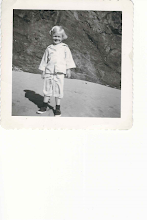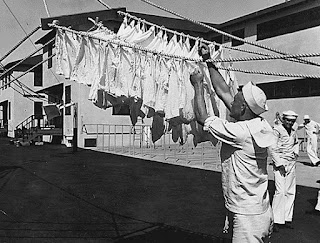Southern
California was a new and delightful experience for all we recruits from the
Pacific Northwest. We saw our first palm
trees somewhere in the vicinity of San Francisco as we rolled south. The rolling hills in that area were brown
from the summer heat, not the lush green of our Douglas fir forests.
When
we stepped off the train at the station in San Diego into bright sunshine, we
inhaled the warm clear air. The sky,
studded with a few puffy cumulus clouds, was an impossible blue. A grey-painted
Navy bus was waiting to transport us to the Naval Training Station through
downtown San Diego and out beyond Lindbergh Field where The Spirit of St. Louis
had been built for Charles Lindbergh’s historic solo flight across the
Atlantic.
It
was obvious at a glance that San Diego was a Navy town. Broadway was thronged with white-uniformed sailors
and a scattering of Marines. The broad
expanse of San Diego Bay held a multitude of grey Navy warships—many destroyers,
cruisers, supply ships, and I could see one aircraft carrier. Silver airplanes were taking off and landing
on North Island against the far horizon of the blue Pacific.
The
Naval Training Station in San Diego was, indeed, a brand new world for me and
the other recruits. When the Navy bus
pulled through the main gate into the main quadrangle and I looked at the stars
and stripes flying over the grassy compound, I somehow felt that I had come “home”. This was where I was meant to be.
The
station was not the big college-type campus that you find in San Diego
today. It, enclosed by a stuccoed wall,
was only two quadrangles bordered by double-deck Spanish-style barracks buildings
with red tiled roofs. They were
connected by covered walkways, also in Spanish motif.
The
first quadrangle, called as we learned “North Unit” was the main part of the
training station. The second, enclosed
by a high chain-link fence, was the isolation unit where all new recruits spent
the first three weeks so that any communicable diseases would have time to
develop. It was known as “South Unit”
and it was the part of the station that contained that contained “the grinder”.
The
grinder was simply a black-topped area of about two acres that was the parade
ground where we would spend our detention time learning to march and do
military drill with a rifle. We would
become all too familiar with “the grinder” but it would instill us with
discipline.
Like
North Unit, the South Unit quadrangle was bordered with those beige red tiles
roofed buildings behind which were concreted areas where tall poles supported a
spider web of clothes lines. The area in
front of the barracks buildings was a green lawn bordered with palm trees and crisscrossed
with concrete sidewalks centering on a tall flagpole from which the colors flew
against that blue sky. The scene was
orderly, clean, and quite beautiful.
When
we recruits stepped down from the bus, we were met by two chief petty officers
who would be our company commanders. Both
were dressed in uniforms of peaked caps with white covers, light blue shirts
with black neckties, dark trousers confined in shiny black puttees, and
glossily shined black shoes. One of the
two, who was a very small dark-haired waspish individual named Nelson. The other, the assistant company commander,
was a large sand-haired “good old boy” type who seemed friendly. His name was Chief Logan.
(We
were to learn at the end that both CPOs were friendly individuals; however, for
the training program they took turns being the “bad guy” and the “good guy”. For Company 40-52, it was Nelsn’s turn to be
the bad guy.)
Chief
Logan lined us up in two rows, showing us how to dress off into straight and
properly spaced lines. The dark-haired
little chief then walked up and down the lines, his hands clasped behind him
and curling his lip as he looked at the motley crew.
I
do not recall his exact acid comments, but the gist of his greeting was that we
were, without a doubt, the sorriest-looking bunch he had ever seen. He had grave doubts that he could make
sailors out of us but it was his job, and that of Chief Logan, to try. Some of us would not make it. His intent was to make us feel like the
lowest things on the face of the Earth. He
pretty much succeeded; however, I saw through his tactic three weeks later. They had me waxing the red-tiled floor of the
nearby chiefs’ mess and wardroom and I overheard another training chief make
exactly the same welcoming speech to another arriving batch for Company 40-53.
It
was late afternoon so we were lined up for Navy haircuts (I came out feeling
like a shorn lamb), given supper (thereafter to be known as “evening chow”),
and quartered for the night in a receiving barracks. The next day, after morning chow, our lives
started moving on the double.
We
endured another physical examination then were issued more clothing and gear
than most of us had ever possessed.
There were four suits of “undress” whites, a dress white jumper with a
blue collar, a black silk neckerchief, a pair of work shoes, a woolen knitted
watch cap, flat hat, four white hats, a dark jersey, black socks and grey socks,
four underwear (known as “skivvies”) of boxer shorts and white tee shirts,
gloves, handkerchiefs, shoe polishing gear, rubber overshoes, and a pair of
khaki leggings. It was all topped off
with a thin horsehair mattress, two mattress covers and pillow cases, a small
pillow, canvas hammock, canvas seabag, a ditty bag for small articles, and a
Bluejacket’s Manual. Our dress uniform would
come later when we were out of South Unit and eligible for liberty.
Most
of the balance of that day was devoted to stenciling our names on each article
of clothing and equipment. It was a court
martial offense to be in possession of another’s clothes. We also shifted into Navy uniforms of undress
whites. All our civilian clothes were
boxed up and shipped home.
For
the balance of our time in South Unit, our daily garb would be undresss whites
(meaning without black neckerchiefs which were only worn for dress parades or going
ashore), that is, clean undress whites and the canvas leggings for
marching. Each afternoon when we secured
from the days marching and drills we were required to shower and in large wood
troughs behind the barracks, scrub every article of clothing we had worn that
day. They were hung on the communal
clothes lines radiating form a central pole.
Cleanliness was a fetish with the Navy.
We
from the Pacific Northwest were the second platoon of Company 40-52 and were
assigned to the second deck of our barracks.
The first floor was occupied by the first platoon made up of Texans who
had arrived two days ahead of us. That
ethnic division was to result in some keep competition (and more than one fight)
between platoons that would result in Company 40-52 earning a Navy E flag for
excellence in military drill as each tried to outdo the other.




No comments:
Post a Comment